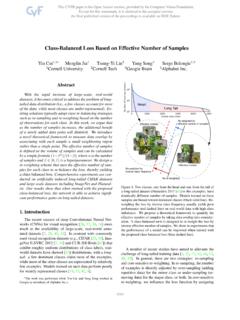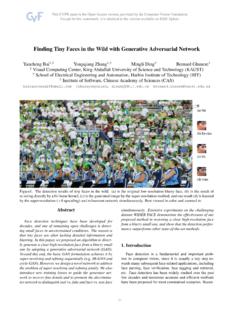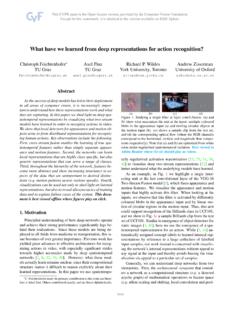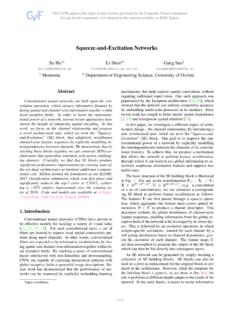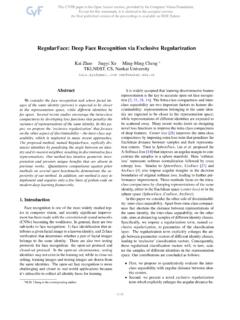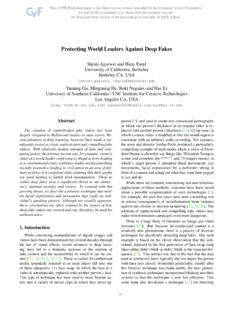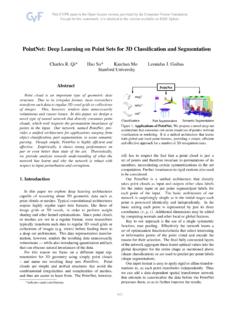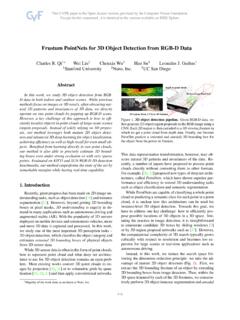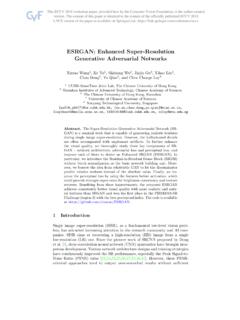Transcription of CornerNet: Detecting Objects as Paired Keypoints
1 CornerNet: Detecting Objects asPaired KeypointsHei Law[0000 0003 1009 164X], Jia Deng[0000 0001 9594 4554]University of Michigan, Ann propose CornerNet, a new approach to object detectionwhere we detect an object bounding box as a pair of Keypoints , thetop-left corner and the bottom-right corner, using a single convolutionneural network. By Detecting Objects as Paired Keypoints , we eliminatethe need for designing a set of anchor boxes commonly used in priorsingle-stage detectors. In addition to our novel formulation,we introducecorner pooling, a new type of pooling layer that helps the network betterlocalize corners. Experiments show that CornerNet achieves a APon MS COCO, outperforming all existing one-stage : object Detection1 IntroductionObject detectors based on convolutional neural networks (ConvNets) [20, 36,15]have achieved state-of-the-art results on various challenging benchmarks [24, 8,9].
2 A common component of state-of-the-art approaches is anchor boxes [32,25], which are boxes of various sizes and aspect ratios that serve as detectioncandidates. Anchor boxes are extensively used in one-stage detectors[25, 10, 31,23], which can achieve results highly competitive with two-stage detectors [32, 12,11, 13] while being more efficient. One-stage detectors place anchor boxesdenselyover an image and generate final box predictions by scoring anchor boxes andrefining their coordinates through the use of anchor boxes has two drawbacks. First, we typically needa very large set of anchor boxes, more than 40k in DSSD [10] and morethan 100k in RetinaNet [23]. This is because the detector is trained to classifywhether each anchor box sufficiently overlaps with a ground truth box, and alarge number of anchor boxes is needed to ensure sufficient overlap with mostground truth boxes.
3 As a result, only a tiny fraction of anchor boxes will overlapwith ground truth; this creates a huge imbalance between positive andnegativeanchor boxes and slows down training [23].Second, the use of anchor boxes introduces many hyperparameters and designchoices. These include how many boxes, what sizes, and what aspect ratios. Suchchoices have largely been made via ad-hoc heuristics, and can become even morecomplicated when combined with multiscale architectures where asingle network2H. Law, J. DengConvNetEmbeddingsHeatmapsTop-Left CornersBottom-Right CornersFig. detect an object as a pair of bounding box corners grouped together. Aconvolutional network outputs a heatmap for all top-left corners, a heatmap for allbottom-right corners, and an embedding vector for each detectedcorner.
4 The networkis trained to predict similar embeddings for corners that belong to the same separate predictions at multiple resolutions, with each scale using differentfeatures and its own set of anchor boxes [25, 10, 23].In this paper we introduce CornerNet, a new one-stage approach to objectdetection that does away with anchor boxes. We detect an object as a pair ofkeypoints the top-left corner and bottom-right corner of the bounding box. Weuse a single convolutional network to predict a heatmap for the top-leftcornersof all instances of the same object category, a heatmap for all bottom-rightcorners, and an embedding vector for each detected corner. The embeddingsserve to group a pair of corners that belong to the same object the networkistrained to predict similar embeddings for them.
5 Our approach greatly simplifiesthe output of the network and eliminates the need for designing anchor approach is inspired by the associative embedding method proposed byNewell et al. [27], who detect and group Keypoints in the context of multipersonhuman-pose estimation. Fig. 1 illustrates the overall pipeline of there is no local evidence to determine the location of a bounding boxcorner. We address this issue by proposing a new type of pooling : Detecting Objects as Paired Keypoints3 Another novel component of CornerNet iscorner pooling, a new type of pool-ing layer that helps a convolutional network better localize cornersof boundingboxes. A corner of a bounding box is often outside the object considerthe caseof a circle as well as the examples in Fig.
6 2. In such cases a corner cannot belocalized based on local evidence. Instead, to determine whetherthere is a top-left corner at a pixel location, we need to look horizontally towards the right forthe topmost boundary of the object , and look vertically towards the bottomforthe leftmost boundary. This motivates our corner pooling layer: it takes in twofeature maps; at each pixel location it max-pools all feature vectors to the rightfrom the first feature map, max-pools all feature vectors directly below from thesecond feature map, and then adds the two pooled results together. An exampleis shown in Fig. mapsoutputtop-left corner poolingFig. pooling: for each channel, we take the maximum values(red dots)in twodirections(red lines), each from a separate feature map, and add the two maximumstogether(blue dot).
7 We hypothesize two reasons why Detecting corners would work betterthanbounding box centers or proposals. First, the center of a box can be harder tolocalize because it depends on all 4 sides of the object , whereas locating a cornerdepends on 2 sides and is thus easier, and even more so with corner pooling,which encodes some explicit prior knowledge about the definition of , corners provide a more efficient way of densely discretizing the space ofboxes: we just needO(wh) corners to representO(w2h2) possible anchor demonstrate the effectiveness of CornerNet on MS COCO [24]. CornerNetachieves a AP, outperforming all existing one-stage detectors. In addition,through ablation studies we show that corner pooling is critical to thesupe-rior performance of CornerNet.
8 Code is available at Law, J. Deng2 Related WorksTwo-stage object detectorsTwo-stage approach was first introduced andpopularized by R-CNN [12]. Two-stage detectors generate a sparse set of regionsof interest (RoIs) and classify each of them by a network. R-CNN generatesRoIs using a low level vision algorithm [41, 47]. Each region is then extractedfrom the image and processed by a ConvNet independently, which creates lots ofredundant computations. Later, SPP [14] and Fast-RCNN [11] improve R-CNNby designing a special pooling layer that pools each region from featuremapsinstead. However, both still rely on separate proposal algorithms and cannotbetrained end-to-end. Faster-RCNN [32] does away low level proposal algorithmsby introducing a region proposal network (RPN), which generates proposals froma set of pre-determined candidate boxes, usually known as anchor boxes.
9 Thisnot only makes the detectors more efficient but also allows the detectors to betrained end-to-end. R-FCN [6] further improves the efficiency of Faster-RCNNby replacing the fully connected sub-detection network with a fully convolutionalsub-detection network. Other works focus on incorporating sub-category infor-mation [42], generating object proposals at multiple scales with more contextualinformation [1, 3, 35, 22], selecting better features [44], improving speed [21], cas-cade procedure [4] and better training procedure [37].One-stage object detectorsOn the other hand, YOLO [30] and SSD [25]have popularized the one-stage approach, which removes the RoI pooling stepand detects Objects in a single network.
10 One-stage detectors are usually morecomputationally efficient than two-stage detectors while maintaining competitiveperformance on different challenging places anchor boxes densely over feature maps from multiple scales,directly classifies and refines each anchor box. YOLO predicts bounding boxcoordinates directly from an image, and is later improved in YOLO9000 [31] byswitching to anchor boxes. DSSD [10] and RON [19] adopt networks similar tothe hourglass network [28], enabling them to combine low-level and high-levelfeatures via skip connections to predict bounding boxes more accurately. How-ever, these one-stage detectors are still outperformed by the two-stage detectorsuntil the introduction of RetinaNet [23].
